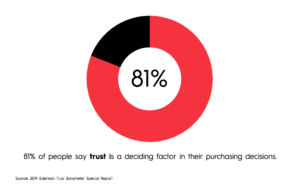Brand Narratives: The power of Story telling in Building Strong Brands

Brand storytelling is no longer nice to have. It is an ABSOLUTE NEED.
Humanity is becoming the new premium in today’s fast-paced, highly automated, and digitally-driven culture. The human touch is becoming rarer and rarer and treasured due to the internet’s constant power to reward us with ease and immediate gratification.
In this environment, businesses can no longer afford to be anonymous. Businesses need to engage customers on a level never before seen, to touch their emotions and pull at their heartstrings.
This is where brand storytelling comes in…
Brand storytelling is the unified narrative that ties together the facts and emotions that your brand elicits. Stories are the best way to engage an audience and tell them why your brand is worth their time, money, and attention.
In this post, you will learn: What is Brand Storytelling? Why it is so important for brands now? How to create a story that works for your company?
Let’s get started!
What Exactly Is Brand Storytelling?
Brand storytelling is a tactic for growing your audience by establishing an emotional connection with them. Your brand narrative is a synthesis of the following:
- Who you are,
- What you do,
- What do you care about, and
- How you assist others.
It’s a narrative about your brand’s existence and why people should connect with you.
Why Is Storytelling So Crucial For Brands Now?

Because people are more likely to buy from someone they like, trust and feel connected to. If a story resonates with your audience, it can make the difference between them buying from you or not.
According to a study by The New York Times, stories help us understand one another and create connections that lead to empathy.
That means your audience must understand who you are, why they should care about you, and what they may have in common with you. But how can you do it efficiently? By telling your brand’s narrative in every piece of content you create.
If you’re on the fence about sharing your brand narrative, here are three reasons why you should.
- Brand narrative distinguishes you.
What distinguishes you? There’s a reason you’re different—whether it’s your product design or service features—and consumers want to know what it is.
You may think it’s self-indulgent, but the most important aspects of your brand’s story—how it came to be, grew, learned to perform excellent work, and chose what it stands for—are more engaging to others than you think.
You may easily beat out your rivals if you aggressively highlight the qualities that set you apart in your content.
- Stories transform the imagination into a virtual reality tool.
With the power of the human imagination, who needs virtual reality technology? In the sense that they stimulate brain regions that affect how you perceive what you see or hear and contribute to your ability to form your own opinions, stories operate as brain fuel. Create a narrative that will stay in the minds of your viewers, and their brains will take care of the rest.
- It brings your brand to life.
People desire to talk to other people. Fortunately, your brand is made up of people (ideally). By revealing that portion of your brand’s narrative, you make it easy for consumers to know who you are and, more crucially, trust you. (The 2019 Edelman Trust Barometer Special Report found that just 34% of individuals trust the brands they consume.)
Too often, companies neglect the power of narrative in favor of focusing on product features, which means they pass up an immense potential to make an impact. Sharing your brand’s story is the most effective method to bridge the gap, establish transparency, and create more meaningful interactions.
Examples of Brand Storytelling
Some businesses have a meaningful narrative inherent in their company and product DNA (e.g., TOMS shoes). In contrast, others must create a creative tale to make their product significant (e.g., most enterprise SaaS companies).
Here are some instances of some of the world’s finest brand storytellers.
- Warby Parker
Warby Parker revolutionized the eyeglass market by making designer eyeglasses cheap, environmentally friendly, and simple to try on at home. Their brand is also built on a compelling tale. One of its founders missed the first semester of graduate school because he misplaced his spectacles on a backpacking trip, and they were too expensive to replace. He and his team decided to address the issue using a plant-based frame structure that is healthier for the environment.
- Coca-Cola
Coca-cola’s legendary Santa ad is an excellent example of brand storytelling. For example, after the brand’s ‘Give and take, say I’ promotion, children began putting Cokes outside their houses for Santa. Their Santa figure is so well-known that simply seeing his face recalls their tales.
- Nike
Nike built itself in people’s imaginations in the 1990s with superb storytelling.
In 1999, they produced a stunning ad to remember Michael Jordan’s career. At a time when everyone was pressing a hard pitch, Nike let Michael Jordan’s story speak for itself. At the conclusion, “Just Do It,” the swoosh emerges, and that’s all the space their brand took up. The tale created an emotional connection between the fans and the player – Nike was just a tiny part of the transaction.
Getting Started with Your Brand’s Story
Fortunately, you’re in better shape than most people if you have a great story and a desire to share it. It’s time to actively spread your message by coming up with creative ways to do it.
Start with the core of your brand.
Your brand’s purpose, vision, mission, and values make up its brand heart. The base of your brand narrative is built on these guiding ideas.
Be distinct in an ocean of similarity.
Having a high-quality product or service is not enough; you also need to know how to market it in a way that sets you apart from the competition. That is why brand storytelling is so crucial.
Focus on building a meaningful, enduring, and authentic brand rather than bombarding your audience with figures, facts, and testimonies. Put your point into a narrative that engages audiences, clarifies facts, and elicits a feeling. Share your brand’s history, difficulties, triumphs, and value propositions through narrative; no other brand can replicate YOUR story.
Make it resonate.
The ultimate aim of every tale is for it to be memorable, resonating with customers for days, if not years. With its Budweiser advertisement during the 2014 Super Bowl, Anheuser-Busch successfully did just that.
An interaction between a puppy and a Clydesdale is depicted in the advertisement. A group of Clydesdales rushes in front of the vehicle to stop the puppy’s adoption and prevent it from being driven away in a car. A brilliant slogan — “best buds” — appears on the screen, connecting the bond with the Budweiser brand. In the end, the puppy is allowed to live on the farm with the Clydesdales. According to a TIVO survey, it was the most-watched Super Bowl commercial in the past 50 years.
Be helpful, not hype-full.
Instead of being excessively promotional, telling true, honest tales will connect with your audience more. Think about the correspondence you get from your preferred brands. Do they make empty promises? Presenting implausible or impossible goals? Most likely not. Find narratives that show your audience how you can assist them. Being human will go a long way in your marketing encounters.
What’s your story?
In a congested marketplace, when everyone is focused on doing things quicker, more effectively, and automatically, be the brand that dares to BE HUMAN. Show your consumers that you care, even if it means (gasp!) slowing down or doing things differently.